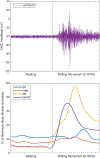Muscle activation and coordinated movements of infant rolling
- PMID: 38147809
- PMCID: PMC10898450
- DOI: 10.1016/j.jbiomech.2023.111890
Muscle activation and coordinated movements of infant rolling
Abstract
Rolling is a critical step of infant development, encouraging muscle coordination and enabling independent exploration. Understanding muscle activity during infant rolling movements on a flat surface is necessary to more fully characterize how the rolling milestone is achieved. The purpose of this study was to determine infants' muscle activation throughout roll initiation for six previously established coordinated movements. Thirty-eight healthy infants (age: 6.5 ± 0.7 months; 23M/15F) were enrolled in this IRB-approved in-vivo biomechanics study. Surface electromyography sensors recorded muscle utilization from the erector spinae, abdominal muscles, quadriceps, and hamstrings while infants rolled. Each rolling movement was categorized as one of six roll types, and the mean muscle activity was analyzed. All roll types required initial activation of all measured muscle groups. Movements featuring axial rotation of the torso relative to the pelvis required highly active erector spinae muscles. Movements featuring trunk and hip flexion required highly active abdominal muscles. Infants used distinct coordinated muscle activations to achieve the six different roll types on a flat surface. A foundational understanding of the different muscle activation patterns required during infant rolling will provide crucial insight into motor development. This study quantified muscle coordination required of infants to achieve rolling on a firm flat surface. Previous research indicates that the mechanical environment in which an infant is placed impacts muscle activity and body position during normal lying. Therefore, future work should explore if mechanical environments that differ from a flat and firm surface also influence these coordinated movements and muscle activations.
Keywords: Biomechanics; Motor development; Pediatrics; Product safety.
Copyright © 2023 Elsevier Ltd. All rights reserved.
Conflict of interest statement
Declaration of Competing Interest EMM provides expert witness consulting related to some infant products. The authors declare that they have no known competing financial interests or personal relationships that could have appeared to influence the work reported in this paper.
Figures





Similar articles
-
Mechanical environment influences muscle activity during infant rolling.Hum Mov Sci. 2024 Jun;95:103208. doi: 10.1016/j.humov.2024.103208. Epub 2024 Mar 14. Hum Mov Sci. 2024. PMID: 38484420 Free PMC article.
-
Arm Differences in Muscle Activity Characteristics During a Bilateral Simulated Overhead Work in Right-Handed and Ambidextrous Individuals.IISE Trans Occup Ergon Hum Factors. 2025 Jun 18:1-13. doi: 10.1080/24725838.2025.2517026. Online ahead of print. IISE Trans Occup Ergon Hum Factors. 2025. PMID: 40534240
-
How do babies roll? Identifying the coordinated movements of infant rolling through video compared to laboratory techniques.Technol Health Care. 2024;32(4):2527-2539. doi: 10.3233/THC-231281. Technol Health Care. 2024. PMID: 38251079 Free PMC article.
-
Assessing the comparative effects of interventions in COPD: a tutorial on network meta-analysis for clinicians.Respir Res. 2024 Dec 21;25(1):438. doi: 10.1186/s12931-024-03056-x. Respir Res. 2024. PMID: 39709425 Free PMC article. Review.
-
Global Delphi consensus on treatment goals for generalized pustular psoriasis.Br J Dermatol. 2025 Mar 18;192(4):706-716. doi: 10.1093/bjd/ljae491. Br J Dermatol. 2025. PMID: 39844356
Cited by
-
Commercial infant products influence body position and muscle use.Early Hum Dev. 2024 Nov;198:106122. doi: 10.1016/j.earlhumdev.2024.106122. Epub 2024 Sep 12. Early Hum Dev. 2024. PMID: 39305831
-
Mechanical environment influences muscle activity during infant rolling.Hum Mov Sci. 2024 Jun;95:103208. doi: 10.1016/j.humov.2024.103208. Epub 2024 Mar 14. Hum Mov Sci. 2024. PMID: 38484420 Free PMC article.
-
Femoral fractures in non-accidental trauma and child abuse: biomechanical perspective and insights.Front Pediatr. 2025 Feb 25;13:1484920. doi: 10.3389/fped.2025.1484920. eCollection 2025. Front Pediatr. 2025. PMID: 40070603 Free PMC article. Review.
References
-
- Altmann TR, and Hill DL (2019). Caring for Your Baby and Young Child: Birth to Age 5. American Academy of Pediatrics. 10.1542/9781610023443 - DOI
-
- Bennett FC (1999). Diagnosing cerebral palsy-the earlier the better. In From: Contemporary Pediatrics (Vol. 16, Issue 7).
Publication types
MeSH terms
Grants and funding
LinkOut - more resources
Full Text Sources
Medical

